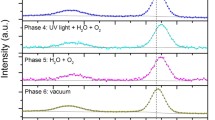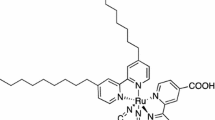Abstract
The dynamic behaviors of conduction-band electrons (\({\text{e}}_{CB}^{ - }\)) and shallow-trap electrons (\({\text{e}}_{ST}^{ - }\)) generated from UV irradiation on ethanol-adsorbed TiO2 and N-TiO2 have been studied by in situ Fourier transform infrared spectroscopy (FTIR) in a diffuse reflectance mode at 300 K and 0.1 MPa. UV irradiation on ethanol-adsorbed TiO2 resulted in the breaking of C–H bond of ethanol, the transfer of electrons from ethanol to the photo-generated holes on TiO2 and N-TiO2, the accumulation of \({\text{e}}_{CB}^{ - }\) and \({\text{e}}_{ST}^{ - }\), and the formation of acetate on TiO2 and the formation of acetate, formate, and formaldehyde on N-TiO2. Accumulated \({\text{e}}_{CB}^{ - }\) and \({\text{e}}_{ST}^{ - }\) are manifested by broad and featureless IR absorbance spectra, which can be fitted into two models for estimation of their relative concentrations. N-doping onto TiO2 produced a higher population of \({\text{e}}_{ST}^{ - }\) and generated \({\text{e}}_{ST}^{ - }\) and \({\text{e}}_{CB}^{ - }\) at a lower rate than TiO2. The average energy level of \({\text{e}}_{ST}^{ - }\) was determined to be 0.30 eV for TiO2 and 0.26 eV for N-TiO2 below the conduction band. Upon terminating UV irradiation, the IR intensity of accumulated \({\text{e}}_{CB}^{ - }\) and \({\text{e}}_{ST}^{ - }\) showed a gradual decay in a time scale of minutes. This study demonstrated that the recombination of photo-generated electrons and holes can be a slow process on TiO2 and N-TiO2 in the presence of adsorbed ethanol under ambient conditions.
Graphical Abstract







Similar content being viewed by others
References
J. Schneider, M. Matsuoka, M. Takeuchi, J. Zhang, Y. Horiuchi, M. Anpo, D.W. Bahnemann, Understanding TiO2 photocatalysis: mechanisms and materials. Chem. Rev. 114(19), 9919–9986 (2014)
M. Anpo, Photocatalysis on small particle TiO2 catalysts. reaction intermediates and reaction mechanisms. Res. Chem. Intermed. 11(1), 67 (1989)
M.R. Hoffmann, S.T. Martin, W. Choi, D.W. Bahnemann, Environmental applications of semiconductor photocatalysis. Chem. Rev. 95(1), 69–96 (1995)
A.L. Linsebigler, G. Lu, J.T. Yates, Photocatalysis on TiO2 surfaces: principles, mechanisms, and selected results. Chem. Rev. 95(3), 735–758 (1995)
M. Anpo, Utilization of TiO2 photocatalysts in green chemistry. Pure Appl. Chem. 72, 1265 (2000)
R. Daghrir, P. Drogui, D. Robert, Modified TiO2 for environmental photocatalytic applications: a review. Ind. Eng. Chem. Res. 52(10), 3581–3599 (2013)
M. Yan, F. Chen, J. Zhang, M. Anpo, Preparation of controllable crystalline titania and study on the photocatalytic properties. J. Phys. Chem. B 109(18), 8673–8678 (2005)
A. Yamakata, T. Ishibashi, H. Onishi, Kinetics of the photocatalytic water-splitting reaction on TiO2 and Pt/TiO2 studied by time-resolved infrared absorption spectroscopy. J. Mol. Catal. A Chem. 199(1–2), 85–94 (2003)
F. Guzman, S.S.C. Chuang, Tracing the reaction steps involving oxygen and IR observable species in ethanol photocatalytic oxidation on TiO2. J. Am. Chem. Soc. 132(5), 1502–1503 (2010)
F. Amano, M. Nakata, A. Yamamoto, T. Tanaka, Effect of Ti3+ ions and conduction band electrons on photocatalytic and photoelectrochemical activity of rutile titania for water oxidation. J. Phys. Chem. C 120(12), 6467–6474 (2016)
T. Berger, M. Sterrer, O. Diwald, E. Knoezinger, D. Panayotov, T.L. Thompson, J.T. Yates Jr., Light-induced charge separation in anatase TiO2 particles. J. Phys. Chem. B 109(13), 6061–6068 (2005)
A.K. Ghosh, F.G. Wakim, R.R. Addiss, Photoelectronic processes in rutile. Phys. Rev. 184(3), 979–988 (1969)
D.A. Panayotov, S.P. Burrows, J.R. Morris, Infrared spectroscopic studies of conduction band and trapped electrons in UV-photoexcited, H-atom n-doped, and thermally reduced TiO2. J. Phys. Chem. C 116(7), 4535–4544 (2012)
Z. Yu, S.S.C. Chuang, In situ IR study of adsorbed species and photogenerated electrons during photocatalytic oxidation of ethanol on TiO2. J. Catal. 246(1), 118–126 (2007)
Y. Cong, J. Zhang, F. Chen, M. Anpo, Synthesis and characterization of nitrogen-doped TiO2 nanophotocatalyst with high visible light activity. J. Phys. Chem. C 111(19), 6976–6982 (2007)
A. Samokhvalov, Hydrogen by photocatalysis with nitrogen codoped titanium dioxide. Renew. Sustain. Energy Rev. 72, 981–1000 (2017)
H. Zhao, Q. Zhang, Y.-X. Weng, Deep Surface trap filling by photoinduced carriers and interparticle electron transport observed in TiO2 nanocrystalline film with time-resolved visible and mid-IR transient spectroscopies. J. Phys. Chem. C 111(9), 3762–3769 (2007)
T. Berger, J.A. Anta, V. Morales-Flórez, Electrons in the band gap: spectroscopic characterization of anatase TiO2 nanocrystal electrodes under fermi level control. J. Phys. Chem. C 116(21), 11444–11455 (2012)
G. Boschloo, D. Fitzmaurice, Electron accumulation in nanostructured TiO2 (anatase) electrodes. J. Phys. Chem. B 103(37), 7860–7868 (1999)
H. Lin, J. Long, Q. Gu, W. Zhang, R. Ruan, Z. Li, X. Wang, In situ IR study of surface hydroxyl species of dehydrated TiO2: towards understanding pivotal surface processes of TiO2 photocatalytic oxidation of toluene. Phys. Chem. Chem. Phys. 14(26), 9468–9474 (2012)
M. Ghosh, M. Lohrasbi, S.S.C. Chuang, S.C. Jana, Mesoporous titanium dioxide nanofibers with a significantly enhanced photocatalytic activity. ChemCatChem 8(15), 2525–2535 (2016)
A. Rismanchian, Y.-W. Chen, S.S.C. Chuang, In situ infrared study of photoreaction of ethanol on Au and Ag/TiO2. Catal. Today 264, 16–22 (2016)
E. Pelizzetti, C. Minero, Mechanism of the photo-oxidative degradation of organic pollutants over TiO2 particles. Electrochim. Acta 38(1), 47–55 (1993)
G. Mattioli, F. Filippone, P. Alippi, A. Amore Bonapasta, Ab initio study of the electronic states induced by oxygen vacancies in rutile and anatase TiO2. Phys. Rev. B 78(24), 241201 (2008)
S.H. Szczepankiewicz, J.A. Moss, M.R. Hoffmann, Electron traps and the stark effect on hydroxylated titania photocatalysts. J. Phys. Chem. B 106(31), 7654–7658 (2002)
D.M. Savory, A.J. McQuillan, IR spectroscopic behavior of polaronic trapped electrons in TiO2 under aqueous photocatalytic conditions. J. Phys. Chem. C 118(25), 13680–13692 (2014)
Acknowledgements
This work was supported by the University of Akron Polymer Science Faculty Initiation Fund. The authors thank Ms. Jie Yu and Mr. P. Patanapaniswa for valuable discussions.
Author information
Authors and Affiliations
Corresponding author
Additional information
Special Issue of the 1st International Symposium on Photocatalysis at Fuzhou University.
Rights and permissions
About this article
Cite this article
Liu, J., Zhang, L., Yao, X. et al. Photo-generated conduction-band and shallow-trap electrons from UV irradiation on ethanol-adsorbed TiO2 and N-TiO2: an in situ infrared study. Res Chem Intermed 43, 5041–5054 (2017). https://doi.org/10.1007/s11164-017-3038-9
Received:
Accepted:
Published:
Issue Date:
DOI: https://doi.org/10.1007/s11164-017-3038-9




